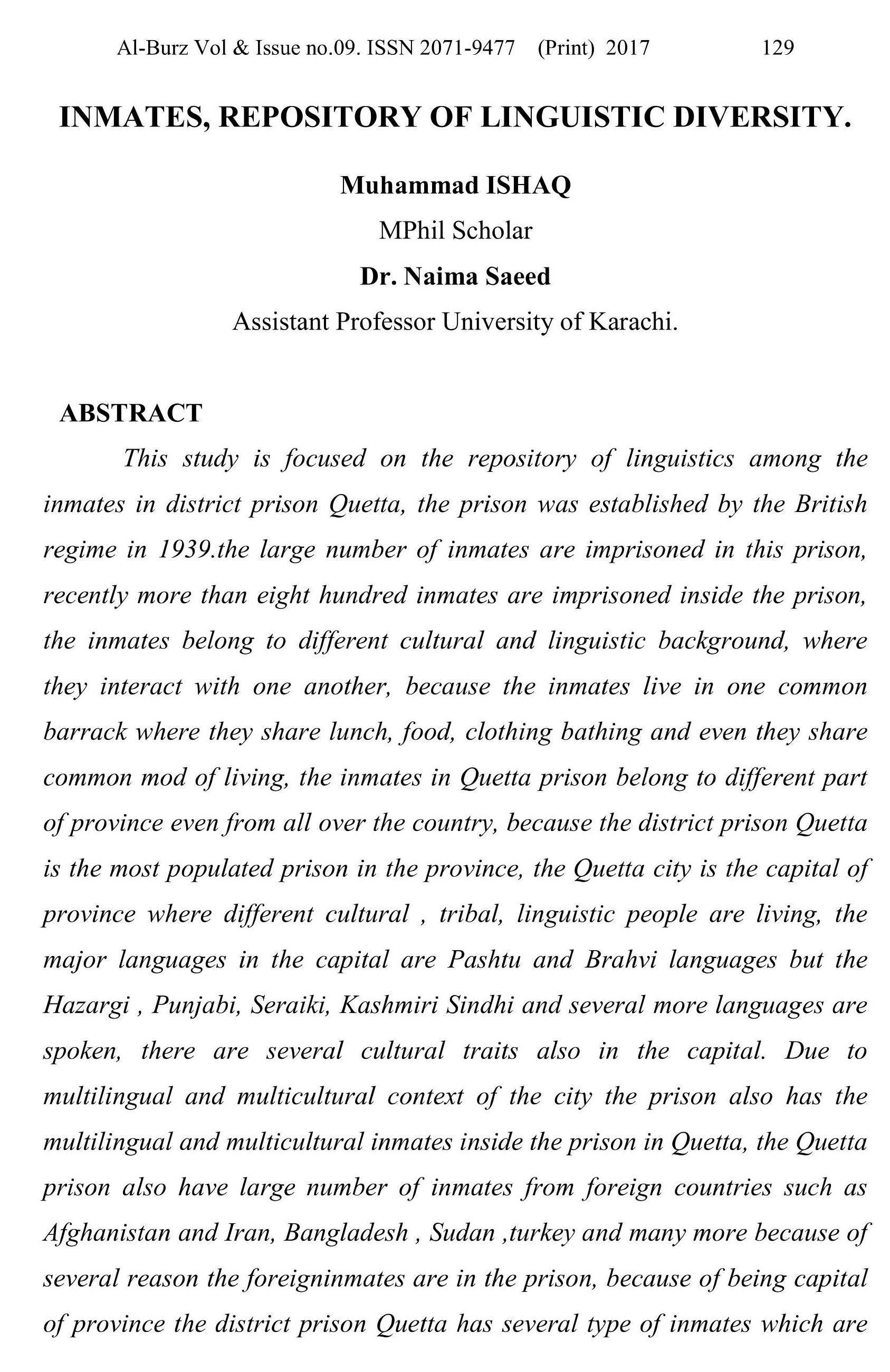INMATES, REPOSITORY OF LINGUISTIC DIVERSITY.
DOI:
https://doi.org/10.54781/abz.v9i1.107Keywords:
Inmates, cultural and linguistic traits, imprisonment, communicationAbstract
This study is focused on the repository of linguistics among the inmates in district prison Quetta, the prison was established by the British regime in 1939.the large number of inmates are imprisoned in this prison, recently more than eight hundred inmates are imprisoned inside the prison, the inmates belong to different cultural and linguistic background, where they interact with one another, because the inmates live in one common barrack where they share lunch, food, clothing bathing and even they share common mod of living, the inmates in Quetta prison belong to different part of province even from all over the country, because the district prison Quetta is the most populated prison in the province, the Quetta city is the capital of province where different cultural , tribal, linguistic people are living, the major languages in the capital are Pashtu and Brahvi languages but the Hazargi , Punjabi, Seraiki, Kashmiri Sindhi and several more languages are spoken, there are several cultural traits also in the capital. Due to multilingual and multicultural context of the city the prison also has the multilingual and multicultural inmates inside the prison in Quetta, the Quetta prison also have large number of inmates from foreign countries such as Afghanistan and Iran, Bangladesh , Sudan ,turkey and many more because of several reason the foreigninmates are in the prison, because of being capital of province the district prison Quetta has several type of inmates which are involved in different type of antisocial activities. The prison have different type of barracks where juvenile, female and male inmates are imprisoned in different barracks, the inmates not only transfer their languages but also their cultural and vocational skills. This process of skill transfer creates several type of interactions among the inmates.
References
(1) Sheikh, K. H., &Arif, G. M. (1989). An Analysis of Rural Homelessness inPakistan. The Pakistan Development Review, 28(4), 925-935.
(2) Mahmood, S., Sheikh, K. H., Mahmood, T., & Malik, M. H. (1991). Food,Poverty andits Causes in Pakistan [with Comments]. The Pakistan Development Review, 30(4), 821-834.
(3) Sawada, Y., &Lokshin, M.(1999). Household schooling decision in rural,Pakistan.World Bank Policy Research Working paper, (2541).
(4) Cekaite, A., &Björk-Willén, P. (2013). Peer group interactions in multilingual educational settings: Co-constructing social order and norms for language use. International Journal of Bilingualism, 17(2), 174-188.
(5)Ahasan, M. R., &Partanen, T. (2001). Occupational Health and Safety in the Least,Developed Countries-A Simple Case of Neglect. Journal of epidemiology, 11(2), 74-80.
(6) Kawakami, T., &Kogi, K. (2001). Action-oriented support for occupational safety and health programs in some developing countries in Asia.International Journal of Occupational Safety and Ergonomics, 7(4), 421-434.
(7)Woolard, K. A. (1989). Sentences in the language prison: The rhetorical structuring of an American language policy debate. American Ethnologist, 16(2), 268-278.
(8)Husain, F., Qasim, M. A., & Sheikh, K. H. (2003). An analysis of publicexpenditure on education in pakistan. The Pakistan development review,42(4), 771-780.
(9)Ross, M. H., & Murray, J. (2004). Occupational respiratory disease in
mining. Occupational Medicine, 54(5), 304-310.
(10)Donoghue, A. M. (2004). Occupational health hazards in mining: anoverview. Occupational Medicine, 54(5), 283-289.
(11)Rickford, J. R. Language Diversity and Academic. Language and Readem, 13.
(12) Memon, G. R. (2007). Education in Pakistan: The key issues, problems and the new challenges. Journal of Management and Social Sciences, 3(1), 47-55.
(13)De Klerk, V., &Barkhuizen, G. (2001). Language usage and attitudes in a South African prison: Who calls the shots?. International journal of the sociology of language, 97-116.
(14)Baugh, J. (1999). Considerations in preparing teachers for linguistic diversity. Language and Readem, 92.
(15)Malik, N., Maan, A. A., Pasha, T. S., Akhtar, S., & Ali, T. (2010). Role of hazard control measures in occupational health and safety in the textile industry of Pakistan. Pak J AgriSci, 47(1), 72-76.
(16)urRehman, H., Faridi, M. Z., & Bashir, F. (2010). Households saving behavior in Pakistan: A case of Multan district. Pakistan Journal of Social Sciences (PJSS), 30(1), 17-29.
(17)Awan, S., Nasrullah, M., & Cummings, K. J. (2010). Health hazards, injury problems, and workplace conditions of carpet-weaving children in three districts of Punjab,Pakistan. International journal of occupational and environmental health, 16(2), 113-119.
(18)Sabir, A. R., &Razzaq, W. Multiculturalism:
(19)Akram, W., Naz, I., & Ali, S. (2011). An Empirical Analysis of
Household Income in Rural Pakistan: Evidences from Tehsil
Samundri. Pakistan Economic and Social Review, 231-249.
(20)Malik, M. S., Basit, A. B., &Qazi, A. K. (2011). Unions and Management: A Case Study of Pakistan Telecommunication Corporation. Pakistan Journal of Social Sciences (PJSS), 31(1), 185-199.
(21)Hassan, S. A. (2012). Health, safety and environmental practices in the construction sector of Pakistan.

Downloads
Published
How to Cite
Issue
Section
License
Copyright (c) 2017 Authors who publish with Al-Burz journal agree to the following terms: 1. Authors retain copyright and grant the journal right of first publication with the work simultaneously licensed under a Creative Commons Attribution (CC-BY) License that allows others to share the work with an acknowledgement of the work's authorship and initial publication in this journal. 2. Authors are able to enter into separate, additional contractual arrangements for the nonexclusive distribution of the journal's published version of the work (e.g., post it to an institutional repository or publish it in a book), with an acknowledgement of its initial publication in this journal.

This work is licensed under a Creative Commons Attribution-NonCommercial-ShareAlike 4.0 International License.
Alburz has licensed under a CC Attribution-NonCommercial-ShareAlike 4.0



